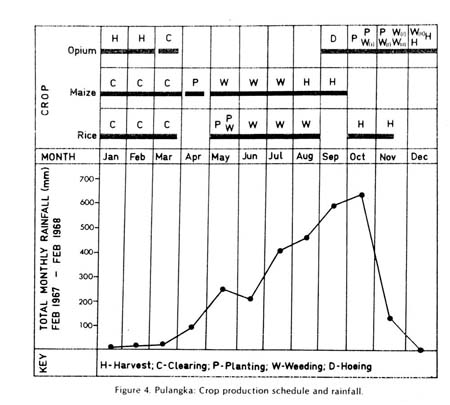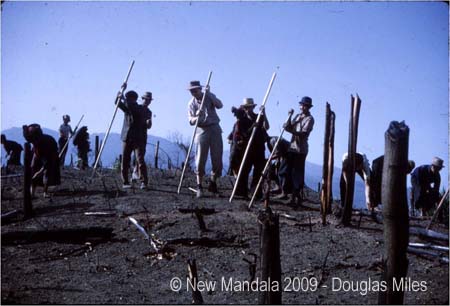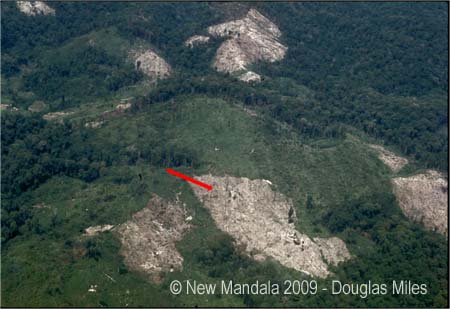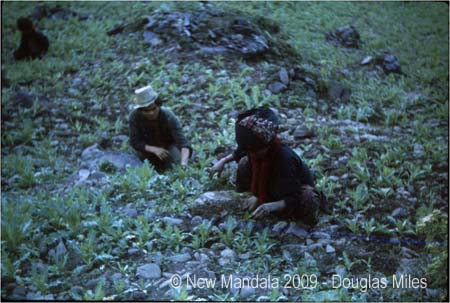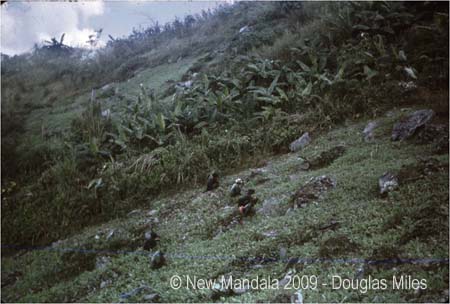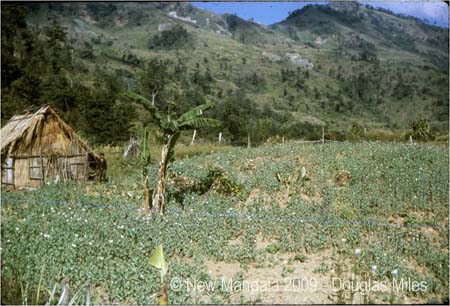From the agricultural cycle of the Pulangka Yao to military “confiscations” by the KMT
Douglas Miles ( CIU, Ascona; James Cook University, ex Tribal Research Centre, Chiang Mai)
Aiontay has made the briefest comment (comment 7, May 14, 2009) to date relating to my initial New Mandala post (May 5, 2009) and to subsequent exchanges with others who have also interconnected shifting cultivation, environmental issues and military activity in the mountains of north Thailand during the mid-1960s. In this case, I reply with a second post mainly because his request for information about Pulangka’s agricultural cycle is to my mind best met by reference to a few images plus captions for which the format of the New Mandala comment box is not entirely suitable . I also appreciate that this is an opportunity to document details of agriculture in Pulangka by dealing with issues which I have never previously had cause to mention in print but which demand attention to-day for reasons which will become obvious below.
Fourteen Months in Every Year
The most accessible of my publications with much of the information that Aiontay requires is probably “The Finger Knife and Ockham’s Razor ” (1979). I here include a copy of Figure 4 in that paper (p.31) as Image 1 which tabulates phases of work in Pulangka’s multi-crop system by reference to both month and rainfall.
Image 1 : Pulangka’s crop production schedule and rainfall
This summary shows that by the reckoning of the Pulangka Yao, each consecutive agricultural cycle extended over 14 months and that January/February marked both the beginning of one cycle and its overlap of several weeks with the one which was just finished.
The working year “started” during January with the slashing of undergrowth on terrain the farmers intended for rice or maize crops . This job was a preliminary to the axing of the largest trees which grew on that clearing and whose climax foliage had previously formed intertwined canopies above the dampness of everything which grew and rotted below. The scheduling of felling later in those months suddenly exposed the resulting slashed and axed debris to weeks of prolonged heat when the probability of rain or cloudiness was zero. Thus began the desiccation of the site’s former jungle cover and a process which would continue into and through the whole of March and thus each cleared grain swiddens was made ready for the spectacular igniting of all of them simultaneously (for reasons of safety) on the same day in the first week of April. And thus the forest on each site transformed into the ash from which the crop would need to draw all of the nutrients on which its growth would depend.
Image 2: Dibbling at Dawn. An anthropologist tries his hand at dibbling on the morning after the burn. He is with other males who each use an iron- capped stick to drill the crust of still warm ash covering the surface of a swidden which has “cooked” throughout the previous night. His stooping companions flick seed rice with remarkable accuracy from their shoulder bags and into the holes he leaves. Note the charred trees which have been left standing during clearing to accelerate their regrowth.
Coping with rock for the sake of poppy. Was this really “shifting” cultivation?
Opium production by Pulangka farmers during my residence in the village entailed a strikingly different schedule from the cereals . By 1966-68 poppy growers had used the same fields for many decades since their forebears first farmed in the area but in such short fallowing cycles that the trees which coppiced on them never attained sufficient maturity to form jungle canopies
Image 3: Aerial photo (1967) . The grey patches are of poppy fields last cultivated two years previously. Consider the logs felled across the slope to reduce erosion through soil slippage. Note the dearth of tree growth in the lighter green areas which are stone -cleared swiddens in about their tenth year of fallow. To-day the farm to which the red arrow points is accessible by road from Pangka (where Yao from Pulangka became refugees in 1968 ) and is a commercial camping park whose facilities (including fresh herb garden, bathroom , kitchen and pergola for dining) are already enjoyed by Thai domestic tourists in both hunting and wildlife -spotlighting excursions. The Yao are investigating prospects to develop the grey clearing to the left of the arrow as a launching pad for paragliding by international tourists. The patch features a gentle slope which begins only metres from a parking space in the park and passes downwards to a sudden unimpeded drop.
By the time of my fieldwork the preparation of none of the poppy farms under crop had required further removal of the limestone fragments and pebbles which are conspicuous on the soil’s surface in Images 4 and 5.
Images 4-5: Weeding poppy fields in November. This is during the simultaneous maximum activity on the rice swiddens which are under harvest by other members of the opium producers’ extended families. Note the relatively small cairn behind the workers in Image 4.
Previous generations had coped with the rubble in two ways which continued to benefit their descendants : (a) by heaping rock into cairns (some of which were of spectacular dimensions) towards the middle of the farm where they have served subsequent generations as useful support structures where cultivated vines such as beans , cucumbers, chokos, marrows and pumpkins have thrived; also (b) by building waist-high dry stone walls along the perimeters where during fallow, they functioned to corral grazing ponies and if athwart the slope like the logs, to reduce soil slippage and erosion during heavy rain. (They were quite similar to dry-stone fences I have seen on rural properties throughout the scenic Cotswalds, UK ) The result over many years was a barely perceptible but certainly recognisable approximation to terracing which enhanced the worth of a prepared field in deals among the Pulangka Yao.
The accumulated labour which predecessors had invested in coping with the stone problem was surely a deterrent against frequent moves to other sites where the Yao calculated that work at reducing surface rubble would have to begin again and literally from scratch (which is an accidental pun in my words but not theirs). But I seriously question in retrospect whether the term “shifting” cultivation is appropriate for poppy farming as practised for more than sixty years in this particular area.
Image 6: (17 February, 1968) An unusually level poppy farm during the driest month when the clearing and desiccation of grain swiddens at lower altitudes is already well advanced. The crop in the foreground is reaching maturity at the end of the agricultural cycle which began 13 months earlier. Note evidence for the thoroughness of both the rubble removal from the surface and of the subsequent hoeing. A substantial cairn off the centre of this farm is not visible in the picture because the anthropologist is sitting upon it (in utter ignorance of its significance) and pointing his lens at everything else. Poppy fields at various stages of fallow after cropping in previous years are evident as sharply sloping clearings up to the ridge in the background. More than 40 years on (in February 2007) the farm with the hut has recently become a commercial camping ground which centers on a football oval and offers guests facilities of bungalows, showers , herb garden and a dining pergola with panoramic views. They bring their own hikers tents for their children to use where they sleep on the oval.
For sale! Rice, maize, silver bullion and children
All Pulangka Yao domestic units grew rice and maize as well as poppies. In previous writing (Miles , 1979; but see also Miles, 1991) I emphasise that they not only did so for their own consumption but also produced consistently sufficient surpluses from year to year to supply by sale almost the entire food needs of some Hmong families of poppy growers who lived in nearby villages and grew little if not nothing of anything else. Such exchange relationships pivoted on guarantees of credit from urban Chinese traders who monopolised the purchase of the Hmong opium and sold silver bullion and Northern Thai children to Yao customers ( Miles, 1972).
The demands of the opium harvest and the technology of rice farming
Overlap between major production tasks in different types of swiddens had very significant implications some of which were manifest in technology. The title of my 1974 paper for example, highlights the use of the “finger knife” by opium producing domestic units to reap their entire rice crop with a metal cutting piece no larger than a razor blade rather than with the sickles and cutting instruments which were otherwise just as much part of Yao farming equipment as they were of the Thai agricultural tool-kit during the 1960s.
The mountain people invested more labour in rice reaping by performing the task with finger knives rather than sickles but thereby minimized the necessity to harvest the grain after it had ripened and during dry weather by scheduling the job for the wettest months of the year (September /October) when the panicles were still green and immature. My paper seeks to explain why they should so inconvenience themselves by such apparently unnecessary additional drudgery. I reveal that these appearances are misleading by presenting further details on the technique by reference to racks for sun-drying and ripening rice on the sheaf rather than in the field and after reaping rather than before . The advantage was the freeing of labour from the cultivation of the food staple during late November /December and the concentration of manpower during those weeks on the most lucrative productive task in Southeast Asian agriculture: opium tapping.
Competition for workers between the opium harvest in January/February and the need to clear jungle during the same months for the following grain farming cycle had environmental advantages. The demand for labour to tap the drug reduced the manpower Yao could simultaneously devote to slashing and axing and thereby the area they could clear for maize in response to the then unlimited demand for the grain stemming from in China and Japan in 1965-68.
Lack of roads to transport this crop to market was no problem for the Pulangka Yao because extended families in their highland village could simply send workers on foot and by bus to towns such as Lampang, Prae and Payao where they stayed initially in Chinese hotels and commuted into the surrounding hills by motorised trishaws or horse and dray to establish maize swiddens close to highways by clearing unexploited jungle and uninhabited terrain which was crown land. The availability of bush materials enabled them to share the labour of building one or two temporary huts on site for workers from several Pulangka domestic units to stay together during the main phases of maize growing. But these Yao shifting cultivators exploited much less jungle than they might have cleared for this crop and allocated far less manpower to that task than their capacity in order to participate in the opium harvest (and the clearing of grain swiddens) closer to Pulangka during January/March.
Ponies and KMT “confiscations” (animal or human?)
All Pulangka domestic units which produced opium kept ponies as pack animals which accompanied them on their ascents into the poppy fields; all owners of the beasts also had maize swiddens as close as they could possibly locate them to the village where they routinely combined cobs with grass feed for ponies in the stables beneath their houses; and for several weeks during every year, each domestic unit also needed to cook a daily swill of maize kernels and chopped banana palm as prime fodder for the pigs they were fattening in log pens to sacrifice at forthcoming ceremonial feasts.
I know of no case in which Kuomintang soldiers ever confiscated any livestock belonging to the Yao, whereas the rank and file of the Royal Thai Army (3rd Region) was notorious for commandeering highland chickens or piglets without ever a hint of payment. But (in my experience and contrary to Aiontay’s concerns) no troops, Thai or Chinese ever appropriated ponies by force or other offers which Yao could not refuse. But I cannot exonerate the KMT from another kind of “confiscation” which was much less acceptable from a humanitarian viewpoint than unprincipled “horse trading”. Indeed, by the mid-1950s its units in Burma and north Thailand remained viable only because they drafted males in situ for combat.
This is not to say that these Nationalist Chinese militia simply kidnapped people. But I do say that the KMT did “confiscate” humans from those to whom the victims of its practices belonged. The “wife” of the commander whom my most recent comment (New Mandala, comment 5, May 13, 2009) mentions was none other than a Yao teenager whom the Pulangka community was called upon to treat as a maiden to be sacrificed as a virilocal bride to the young Taiwanese general who became her groom. She also became his hostage whose welfare in his barracks he guaranteed provided the Pulangka headman collected a required amount of opium from Yao constituents and paid that quota to ensure not only her protection by the KMT but also the extension of that benefit to all domestic units in the village. Her confiscation from her home was an amputation from her previous existence and forced her to abandon embroidery and therefore even the everyday dress of a Yao woman. But she still expressed nothing but adulation for her Taiwanese warlord and during the onset of the general’s imminent repatriation to Taipei, almost 18 years later, he at least made moves to ensure the well -being of their two children (one an adolescent boy) and their Yao grandmother (also an addict) by delivering all three “home” to Pulangka and indeed into paid employment by me of the only worker among them. Her name was Mannai ,who was the mother of the two youngsters and the daughter of the old lady. She saw herself as fulfilling his orders in absentia by becoming a diligent domestic companion for my wife (the school teacher) and our little daughter throughout the years I lived in Pulangka by the end of which her 16 year old son had harvested her first rice swidden and rescued his Yao family from the cusp of possible beggary on my eventual departure.
She had been exposed to the fate she had suffered because the domestic unit of her birth owed a spouse in lieu of the bridewealth her deceased father should have paid for her mother. The headman settled this debt with a loan from a Chinese trader in Chiengrai. Under long- entrenched understandings between Chinese merchants and their highland customers, the Yao chief had every right to arrange her virilocal “marriage” with the general and accept KMT protection as a substitute for bridewealth ( Miles,1972) .
Consider by comparison the child-soldiers who constituted the rank-and-file of the KMT units in this area during the late sixties. There were no Yao (or Hmong) amongst their troops and only very few with origins from other mountain minorities (such as Akha, Lisu and Lahu). The dozen or so local recruits whose origins I knew most about were all sons of landless northern Thai (khon muang) lowlanders. They had resided with and worked for Chinese traders in northern Thai towns and cities as collateral for their parents’ debts for some months before becoming soldiers. They had begun their military careers by being “confiscated” rather than conscripted by the KMT when they had then substituted for the fees and commissions which the mounted militia charged to escort the pony caravans of these businessmen through the mountains. Some of these youngsters told me that one pony in any caravan under their escort was likely to have a packet of opium in its panniers. They never knew which. Several of these armed youths appear on parade in Adrian Cowell’s 1976 documentary The Opium Warlords and look remarkably pubescent. They were. And by contrast with conscripts in the Royal Thai Army, the financial circumstances of their “confiscation” made it impossible for them to abscond with any confidence of support from their own kin or former employers.
Bomb shattered wldlife and pack animals?
Regarding Aiontay’s final question, how could anyone know what or how many wild animals have became victims of the landmines they might have detonated in the jungles around Pulangka. But I am sad to have to say that that some of the Yao ponies which so interest Aiontay have certainly met that fate. From coffee-shop conversations, I guess that about a dozen pack animals from Pangka have done so during the last forty years and even though they have not strayed very far when grazing into the hills above the village. The evidence includes bones near places where experts have recently deactivated mines. The good news for the promoters of spotlighting and paragliding is the confidence of these specialists that all of the mines have been located; that further explosions are now “very unlikely” and during the last few month the endorsement of that message in an official announcement of the former village headman who is notorious for his implacably persistent skepticism towards the optimists.
References
Miles, D. 1972b “Yao Bride-exchange , Matrifiation and Adoption”, Bijdragen tot de Taal- Land- en Volkenkunde, 128: 99-117.
Miles, D. 1979″The Finger Knife and Ockham’s Razor – A Problem in Culture History and Economic Anthropology” American Ethnologist No.2 223 -43.
Miles, D. 1990 ” Capitalism and the Structure of Yao Descent Units: A Comparison of Youling (1938) and Pulangka (1968)” In GehanWijeyewardene (ed) Ethnic Groups across National Boundaries in Mainland Southeast Asia Singapore, ISEAS 1990, pp 134-148.
Acknowledgement
Thanks to Mr. Sanjay of CIU Ascona, Switzerland for availing me of his technical expertise.
 Facebook
Facebook  Twitter
Twitter  Soundcloud
Soundcloud  Youtube
Youtube  Rss
Rss 